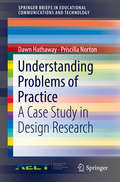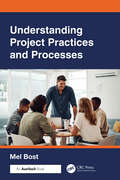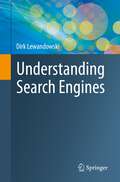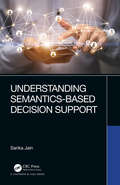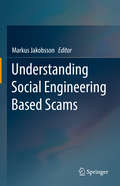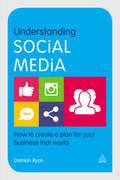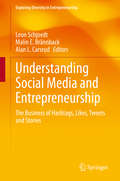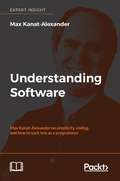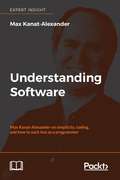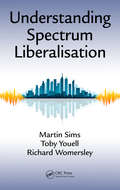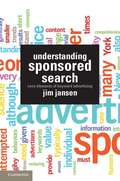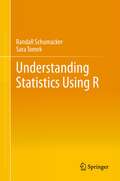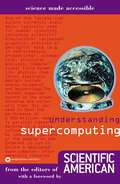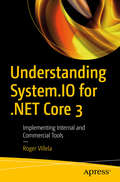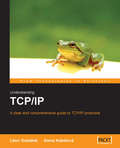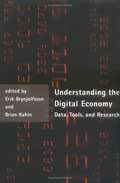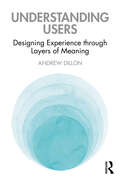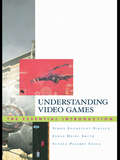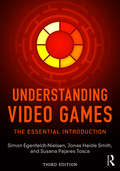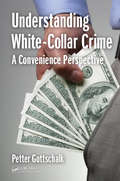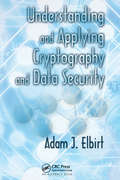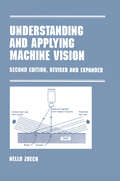- Table View
- List View
Understanding Portrait Photography: How to Shoot Great Pictures of People Anywhere
by Bryan PetersonCapture the perfect portrait--even if it's with a selfie--in this updated edition of a trusted classic, now with all-new photography.Great portraits go beyond a mere record of a face. They reveal one of the millions of intimate human moments that make up a life. In Understanding Portrait Photography, renowned photographer Bryan Peterson shows how to spot those "aha!" moments and capture them forever. Rather than relying on pure luck and chance to catch those moments, Peterson's approach explains what makes a photo memorable, how to spot the universal themes that everyone can identify with, and how to use lighting, setting, and exposure to reveal the wonder and joy of everyday moments. This updated edition includes new sections on capturing the perfect selfie, how to photograph in foreign territory while being sensitive to cultures and customs, how to master portraiture on an iPhone, and the role of Photoshop in portraiture. Now with brand-new photography, Understanding Portrait Photography makes it easy to create indelible memories with light and shadow.
Understanding Problems of Practice: A Case Study In Design Research (Springerbriefs In Educational Communications And Technology Ser.)
by Dawn Hathaway Priscilla NortonToday, K-12 practitioners are challenged to become educational innovators. Yet, little is available to the practitioner to guide their reflection about the design, development, and implementation of these innovations in their own practice. This brief approaches such problems of practice from the perspectives of design research. Although design research typically centers on the partnership between researchers and practitioners in real-world settings, relationships between researchers and practitioners are not always practical. In this brief, the authors explore how the design research process can make the goals, assumptions, processes, methods, and outcomes of design research uniquely accessible to the practitioner. In clear, explicit language, it introduces design research to practitioners using both expository discussions and a robust narrative case study approach that ably guides the reader through the phases of design research, namely:Theory to innovation to practiceUnderstanding problems of practiceCreating a design solutionAssessing the design solutionEvaluating learning outcomesCapturing lessons for practiceUnderstanding Problems of Practice is a singular resource for teachers and practitioners enrolled in graduate research courses or courses on teacher leadership. It also lends itself well as a supplement to professional development activities and studies at the district, school, and professional learning community levels.
Understanding Project Practices and Processes
by Mel BostUnderstanding Project Practices and Processes distills the author’s experiences in developing program management offices (PMOs) and as an IT project office to guide project managers who may be facing challenges in delivering project goals and managing teams and stakeholders. With insights into the behavior of project teams, project managers, stakeholders, and project organizations, the book brings to life such processes and practices of project management as risk management, innovation, and design thinking.In presenting principles dedicated to achieving successfully good, sound business and technological maturity, the book explains the following: Using lessons learned to improve processes. When to implement process improvement to better attain goals. Process capability maturity as a continuous process of improving and maturing a process to achieve consistent and repeatable results. Distinction between processes and projects. How projects turn a strategy into action. Key roles of communications and technology. Research and real-world scenarios explain the practice of project management. With in-depth coverage of project management offices, knowledge management, change management, and project best practices, this book is an indispensable guide for new, as well as veteran, project managers.
Understanding Search Engines
by Dirk LewandowskiThis book provides a broad introduction to search engines by integrating five different perspectives on Web search and search engines that are usually dealt with separately: the technical perspective, the user perspective, the internet-based research perspective, the economic perspective, and the societal perspective.After a general introduction to the topic, two foundational chapters present how search tools can cover the Web’s content and how search engines achieve this by crawling and processing the found documents. The next chapter on user behavior covers how people phrase their search queries and interact with search engines. This knowledge builds the foundation for describing how results are ranked and presented. The following three chapters then deal with the economic side of search engines, i.e., Google and the search engine market, search engine optimization (SEO), and the intermingling of organic and sponsored search results. Next, the chapter on search skills presents techniques for improving searches through advanced search interfaces and commands. Following that, the Deep Web and how its content can be accessed is explained. The two subsequent chapters cover ways to improve the quality of search results, while the next chapter describes how to access the Deep Web. Last but not least, the following chapter deals with the societal role of search engines before the final chapter concludes the book with an outlook on the future of Web search.With this book, students and professionals in disciplines like computer science, online marketing, or library and information science will learn how search engines work, what their main shortcomings are at present, and what prospects there are for their further development. The different views presented will help them to understand not only the basic technologies but also the implications the current implementations have concerning economic exploitation and societal impact.
Understanding Semantics-Based Decision Support
by Sarika JainThis book is an attempt to establish in the readers the importance of creating interoperable data stores and writing rules for handling this data. It also covers extracts from a few project dissertations and a research funded project that the author had supervised.• Describes the power of ontologies for better data management• Provides an overview of knowledge engineering including ontology engineering, tools and techniques• Provides sample development procedures for creating two domain ontologies.• Depicts the utility of ontological representation in situation awareness• Demonstrates recommendation engine for unconventional emergencies using a hybrid reasoning approach.• The text explains how to make better utilization of resources when emergency strikesGraduates and undergraduates doing courses in artificial intelligence, semantic web and knowledge engineering will find this book beneficial.
Understanding Semiconductors: A Technical Guide for Non-Technical People
by Corey RichardGain complete understanding of electronic systems and their constituent parts. From the origins of the semiconductor industry right up until today, this book serves as a technical primer to semiconductor technology. Spanning design and manufacturing to the basic physics of electricity, it provides a comprehensive base of understanding from transistor to iPhone. Melding an accessible, conversational style with over 100 diagrams and illustrations, Understanding Semiconductors provides clear explanations of technical concepts going deep enough to fully explain key vernacular, mechanisms, and basic processes, without getting lost in the supporting theories or the theories that support the supporting theories. Concepts are tethered to the real world with crisp analysis of industry dynamics and future trends. As a break from the straight-ahead scientific concepts that keep the world of semiconductors spinning, Understanding Semiconductors is liberally sprinkled with apt analogies that elucidate difficult concepts. For example, when describing the relationship between voltage, current, power, and the flow of electricity through an electronic system, the book draws a parallel to a hot shower and the water utility system. Most of these are paired with clear visuals, giving you the best chance possible to absorb the concept at hand before moving on to the next topic. Whether you’re narrowly technical or don’t know silicon from silly putty, working directly in hardware technologies and want to know more, or simply a curious person seeking hard information about the technology that powers the modern world, Understanding Semiconductors will be an informative, dependable resource. What You'll Learn: Charge, Electricity, and Basic Physics What are Semiconductors The Semiconductor Value Chain and Design Trade-Offs Transistors and Other Common Circuit Building Blocks Semiconductor Design from Concept to Tapeout Wafer Fabrication and Semiconductor Manufacturing Process Integrated Circuit (IC) Packaging and Signal & Power Integrity (SIPI) Common Circuits and System Components RF and Wireless Technologies System Architecture and Integration The Semiconductor Industry - Challenges, History, and Trends The Future of Semiconductors and Electronic Systems Who This Book Is For: People working directly in the semiconductor, electronics, and hardware technologies fields or in supporting industries, hobbyists and new electrical engineering enthusiasts with minimal technical experience or pre-existing qualifications, and curious individuals interested in learning more about a fascinating area of technology. Though designed for a non- or semi-technical reader, engineers focused in one particular domain can also use this book to broaden their understanding in areas that aren’t directly related to their core area of expertise.
Understanding Social Engineering Based Scams
by Markus JakobssonThis book describes trends in email scams and offers tools and techniques to identify such trends. It also describes automated countermeasures based on an understanding of the type of persuasive methods used by scammers. It reviews both consumer-facing scams and enterprise scams, describing in-depth case studies relating to Craigslist scams and Business Email Compromise Scams. This book provides a good starting point for practitioners, decision makers and researchers in that it includes alternatives and complementary tools to the currently deployed email security tools, with a focus on understanding the metrics of scams. Both professionals working in security and advanced-level students interested in privacy or applications of computer science will find this book a useful reference.
Understanding Social Media
by Damian RyanUnderstanding Social Media is the essential guide to social media for students and professionals alike. Drawing on the experience, advice and tips from dozens of digital marketers and social media superstars, it is an extensive crowd-sourced guide to social media platforms. Illustrated throughout with case studies from both successful and failed campaigns, Understanding Social Media democratizes knowledge of social media and promotes best practice, answering questions such as 'How do you create a compelling social media campaign?', 'How do you build and engage with an audience?' and 'Where is the line between online PR and social media drawn?' It is the most comprehensive and practical reference guide to social media available.
Understanding Social Media and Entrepreneurship: The Business of Hashtags, Likes, Tweets and Stories (Exploring Diversity in Entrepreneurship)
by Alan L. Carsrud Leon Schjoedt Malin E. BrännbackSocial media offers an opportunity for people to enlarge their exposure to information; information about important changes and trends in technology, markets, government policies, or society in general that can facilitate entrepreneurship, business development, and more. Despite the widespread cultural and social effects of social media in the way people communicate and interact, little research has addressed the role of social media in entrepreneurship. This book fills this gap by exploring the influence and consequences social media has on entrepreneurship at the individual level, group level, venture (firm) level and societal level. Specific social media platforms (e.g., Facebook, Twitter, Instagram, etc.) will be explored as well as topics such as gender, education and socioemotional wealth.
Understanding Software
by Max Kanat-AlexanderSoftware legend Max Kanat-Alexander shows you how to succeed as a developer by embracing simplicity, with forty-three essays that will help you really understand the software you work with. About This Book • Read and enjoy the superlative writing and insights of the legendary Max Kanat-Alexander • Learn and reflect with Max on how to bring simplicity to your software design principles • Discover the secrets of rockstar programmers and how to also just suck less as a programmer Who This Book Is For Understanding Software is for every programmer, or anyone who works with programmers. If life is feeling more complex than it should be, and you need to touch base with some clear thinking again, this book is for you. If you need some inspiration and a reminder of how to approach your work as a programmer by embracing some simplicity in your work again, this book is for you. If you're one of Max's followers already, this book is a collection of Max's thoughts selected and curated for you to enjoy and reflect on. If you're new to Max's work, and ready to connect with the power of simplicity again, this book is for you! What You Will Learn • See how to bring simplicity and success to your programming world • Clues to complexity - and how to build excellent software • Simplicity and software design • Principles for programmers • The secrets of rockstar programmers • Max's views and interpretation of the Software industry • Why Programmers suck and how to suck less as a programmer • Software design in two sentences • What is a bug? Go deep into debugging In Detail In Understanding Software, Max Kanat-Alexander, Technical Lead for Code Health at Google, shows you how to bring simplicity back to computer programming. Max explains to you why programmers suck, and how to suck less as a programmer. There's just too much complex stuff in the world. Complex stuff can't be used, and it breaks too easily. Complexity is stupid. Simplicity is smart. Understanding Software covers many areas of programming, from how to write simple code to profound insights into programming, and then how to suck less at what you do! You'll discover the problems with software complexity, the root of its causes, and how to use simplicity to create great software. You'll examine debugging like you've never done before, and how to get a handle on being happy while working in teams. Max brings a selection of carefully crafted essays, thoughts, and advice about working and succeeding in the software industry, from his legendary blog Code Simplicity. Max has crafted forty-three essays which have the power to help you avoid complexity and embrace simplicity, so you can be a happier and more successful developer. Max's technical knowledge, insight, and kindness, has earned him a status as a code guru, and his ideas will inspire you and help refresh your approach to the challenges of being a developer. Style and approach Understanding Software is a new selection of carefully chosen and crafted essays from Max Kanat-Alexander's legendary blog call Code Simplicity. Max's writing and thoughts are great to sit and read cover to cover, or if you prefer you can drop in and see what you discover new every single time!
Understanding Software
by Max Kanat-AlexanderSoftware legend Max Kanat-Alexander shows you how to succeed as a developer by embracing simplicity, with forty-three essays that will help you really understand the software you work with. About This Book Read and enjoy the superlative writing and insights of the legendary Max Kanat-Alexander Learn and reflect with Max on how to bring simplicity to your software design principles Discover the secrets of rockstar programmers and how to also just suck less as a programmer Who This Book Is For Understanding Software is for every programmer, or anyone who works with programmers. If life is feeling more complex than it should be, and you need to touch base with some clear thinking again, this book is for you. If you need some inspiration and a reminder of how to approach your work as a programmer by embracing some simplicity in your work again, this book is for you. If you're one of Max's followers already, this book is a collection of Max's thoughts selected and curated for you to enjoy and reflect on. If you're new to Max's work, and ready to connect with the power of simplicity again, this book is for you! What You Will Learn See how to bring simplicity and success to your programming world Clues to complexity - and how to build excellent software Simplicity and software design Principles for programmers The secrets of rockstar programmers Max's views and interpretation of the Software industry Why Programmers suck and how to suck less as a programmer Software design in two sentences What is a bug? Go deep into debugging In Detail In Understanding Software, Max Kanat-Alexander, Technical Lead for Code Health at Google, shows you how to bring simplicity back to computer programming. Max explains to you why programmers suck, and how to suck less as a programmer. There's just too much complex stuff in the world. Complex stuff can't be used, and it breaks too easily. Complexity is stupid. Simplicity is smart. Understanding Software covers many areas of programming, from how to write simple code to profound insights into programming, and then how to suck less at what you do! You'll discover the problems with software complexity, the root of its causes, and how to use simplicity to create great software. You'll examine debugging like you've never done before, and how to get a handle on being happy while working in teams. Max brings a selection of carefully crafted essays, thoughts, and advice about working and succeeding in the software industry, from his legendary blog Code Simplicity. Max has crafted forty-three essays which have the power to help you avoid complexity and embrace simplicity, so you can be a happier and more successful developer. Max's technical knowledge, insight, and kindness, has earned him code guru status, and his ideas will inspire you and help refresh your approach to the challenges of being a developer. Style and approach Understanding Software is a new selection of carefully chosen and crafted essays from Max Kanat-Alexander's legendary blog call Code Simplicity. Max's writing and thoughts are great to sit and read cover to cover, or if you prefer you can drop in and see what you discover new every single time!
Understanding Spectrum Liberalisation
by Martin Sims Toby Youell Richard WomersleyUntil the 1990s, almost all spectrum licenses were given away practically for free-even the first mobile licenses which laid the foundation for multi-billion dollar companies that dominate stock markets around the world. In the past fifteen years, there has been a concerted attempt to liberalise the sector and make it more open to market forces. Th
Understanding Sponsored Search: Core Elements of Keyword Advertising
by Jim JansenThis book addresses the underlying foundational elements, both theoretical and methodological, of sponsored search. As such, the contents are less affected by the ever-changing implementation aspects of technology. Rather than focusing on the how, this book examines what causes the how. Why do certain keywords work, while others do not? Why does that ad work well, when others that are similar do not? Why does a key phrase cost a given amount? Why do we measure what we do in keyword advertising? This book speaks to that curiosity to understand why we do what we do in sponsored search. The content flows through the major components of any sponsored search effort, regardless of the underlying technology or client or product. The book addresses keywords, ads, consumers, pricing, competitors, analytics, branding, marketing, and advertising, integrating these separate components into an incorporated whole. The focus is on the critical elements, with ample illustrations, and with enough detail to lead the interested reader to further inquiry.
Understanding Statistics Using R
by Randall Schumacker Sara TomekThis book was written to provide resource materials for teachers to use in their introductory or intermediate statistics class. The chapter content is ordered along the lines of many popular statistics books so it should be easy to supplement the content and exercises with class lecture materials. The book contains R script programs to demonstrate important topics and concepts covered in a statistics course, including probability, random sampling, population distribution types, role of the Central Limit Theorem, creation of sampling distributions for statistics, and more. The chapters contain T/F quizzes to test basic knowledge of the topics covered. In addition, the book chapters contain numerous exercises with answers or solutions to the exercises provided. The chapter exercises reinforce an understanding of the statistical concepts presented in the chapters. An instructor can select any of the supplemental materials to enhance lectures and/or provide additional coverage of concepts and topics in their statistics book. This book uses the R statistical package which contains an extensive library of functions. The R software is free and easily downloaded and installed. The R programs are run in the R Studio software which is a graphical user interface for Windows. The R Studio software makes accessing R programs, viewing output from the exercises, and graphical displays easier to manage. The first chapter of the book covers the fundamentals of the R statistical package. This includes installation of R and R Studio, accessing R packages and libraries of functions. The chapter also covers how to access manuals and technical documentation, as well as, basic R commands used in the R script programs in the chapters. This chapter is important for the instructor to master so that the software can be installed and the R script programs run. The R software is free so students can also install the software and run the R script programs in the chapters. Teachers and students can run the R software on university computers, at home, or on laptop computers making it more available than many commercial software packages.
Understanding Supercomputing
by Editors of Scientific AmericanA guide to understanding supercomputing and its applications.
Understanding System.IO for .NET Core 3: Implementing Internal and Commercial Tools
by Roger VillelaTake full advantage of the .NET APIs in System.IO to achieve fundamental I/O operations and produce better quality software. You’ll start with the basics of creating a .NET Core custom library for System.IO. You will learn the purpose and benefits of a custom cross-platform .NET Core library along with the implementation architecture of the custom library components. Moving forward, you will learn how to use the .NET APIs of System.IO for getting information about resources. Here, you will go through drives, directories, files, and much more in the .NET API. You’ll discuss manipulation of resources and the environment, where you will learn how to build custom IO actions for resource manipulation followed by its properties and security. Next, you will learn special .NET API operations with System.IO with demonstrations on working with collection of resources, directories, files, and system information. Finally, you will go through the managed and unmanaged streams in the .NET API such as memory stream, file stream, and much more.After reading Understanding System.IO for .NET Core 3, you will be able to work with different features of .System.IO in .NET Core and implement its internal and commercial tools for different I/O scenarios.What You Will Learn Discover the inner workings of the System.IO BCL implementation on the .NET Core platform Work with System.IO mechanisms available through the .NET Core platform Write a custom library that encapsulates .NET APIs from System.IO Design and implement various tools in System.IO Who This Book Is ForDevelopers with prior experience of working in .NET or .NET Core.
Understanding TCP/IP
by Alena KabelováThis book is suitable for the novice and experienced system administrators, programmers, and anyone who would like to learn how to work with the TCP/IP protocol suite. It can be read even by those who have little background in networking
Understanding The Digital Economy: Data, Tools, and Research
by Brian Kahin Erik BrynjolfssonThe rapid growth of electronic commerce, along with changes in information, computing, and communications, is having a profound effect on the United States economy. President Clinton recently directed the National Economic Council, in consultation with executive branch agencies, to analyze the economic implications of the Internet and electronic commerce domestically and internationally, and to consider new types of data collection and research that could be undertaken by public and private organizations. This book contains work presented at a conference held by executive branch agencies in May 1999 at the Department of Commerce. The goals of the conference were to assess current research on the digital economy, to engage the private sector in developing the research that informs investment and policy decisions, and to promote better understanding of the growth and socioeconomic implications of information technology and electronic commerce. Aspects of the digital economy addressed include macroeconomic assessment, organizational change, small business, access, market structure and competition, and employment and the workforce.
Understanding Users: Designing Experience through Layers of Meaning
by Andrew DillonGrounded in the user-centered design movement, this book offers a broad consideration of how our civilization has evolved its technical infrastructure for human purpose to help us make sense of our contemporary information infrastructure and online existence. The author incorporates historical, cultural, and aesthetic approaches to situating information and its underlying technologies across time in the collective, lived experiences of humanity. In today’s digital environment, user experience is vital to the success of any product or service. Yet as the user population expands to include us all, designing for people who vary in skills, abilities, preferences, and backgrounds is challenging. This book provides an integrated understanding of users, and the methods that have evolved to identify usability challenges, that can facilitate cohesive and earlier solutions. The book treats information creation and use as a core human behavior based on acts of representation and recording that humans have always practiced. It suggests that the traditional ways of studying information use, with their origins in the distinct layers of social science theories and models is limiting our understanding of what it means to be an information user and hampers our efforts at being truly user-centric in design. Instead, the book offers a way of integrating the knowledge base to support a richer view of use and users in design education and evaluation. Understanding Users is aimed at those studying or practicing user-centered design and anyone interested in learning how people might be better integrated in the design of new technologies to augment human capabilities and experiences.
Understanding Video Games: The Essential Introduction
by Simon Egenfeldt-Nielsen Jonas Heide Smith Susana Pajares ToscaFrom Pong to PlayStation 3 and beyond, Understanding Video Games is the first general introduction to the exciting new field of video game studies. This textbook traces the history of video games, introduces the major theories used to analyze games such as ludology and narratology, reviews the economics of the game industry, examines the aesthetics of game design, surveys the broad range of game genres, explores player culture, and addresses the major debates surrounding the medium, from educational benefits to the effects of violence. Throughout the book, the authors ask readers to consider larger questions about the medium: what defines a video game? who plays games? why do we play games? how do games affect the player? Extensively illustrated, Understanding Video Games is an indispensable and comprehensive resource for those interested in the ways video games are reshaping entertainment and society. A Companion Website (www.routledge.com/textbooks/9780415977210) features student resources including discussion questions for each chapter, a glossary of key terms, a video game timeline, and links to other video game studies resources for further study.
Understanding Video Games: The Essential Introduction
by Simon Egenfeldt-Nielsen Jonas Heide Smith Susana Pajares ToscaFrom Pong to PlayStation 3 and beyond, Understanding Video Games is the first general introduction to the exciting new field of video game studies. This textbook traces the history of video games, introduces the major theories used to analyze games such as ludology and narratology, reviews the economics of the game industry, examines the aesthetics of game design, surveys the broad range of game genres, explores player culture, and addresses the major debates surrounding the medium, from educational benefits to the effects of violence. Throughout the book, the authors ask readers to consider larger questions about the medium: what defines a video game? who plays games? why do we play games? how do games affect the player? Extensively illustrated, Understanding Video Games is an indispensable and comprehensive resource for those interested in the ways video games are reshaping entertainment and society. A Companion Website (www.routledge.com/textbooks/9780415977210) features student resources including discussion questions for each chapter, a glossary of key terms, a video game timeline, and links to other video game studies resources for further study.
Understanding Weightless
by William WebbEssential for getting to grips with the Weightless standard for M2M communications, this definitive guide describes and explains the new standard in an accessible manner. It helps you to understand the Weightless standard by revealing its background and rationale. Designed to make clear the context and the fundamental design decisions for Weightless and to provide a readable overview of the standard, it details principal features and issues of the technology, the business case for deployment, network performance and some important applications. This informative book guides you through the key decisions and requirements involved in designing and deploying a Weightless network. Includes a chapter on applications, explaining the relevance of the standard and its potential. Written by one of the lead designers of Weightless, this is an ideal guide for everyone involved with the standard, from those designing equipment to those making use of the technology.
Understanding White-Collar Crime: A Convenience Perspective
by Petter GottschalkUnderstanding White-Collar Crime develops the concept of convenience as the main explanation for crime occurrence. Examining all three dimensions of crime—economic, organizational, and behavioral—the book argues that when white-collar crime becomes less convenient, crime rates will go down. By applying convenience theory to an empirical sample of convicted white-collar criminals, the text teaches criminal justice students and ethics and compliance practitioners to identify and understand how opportunity affects real-world criminal situations. Internal investigations of white-collar crime are discussed, and corporate social responsibility against white-collar crime is emphasized. Understanding White-Collar Crime: A Convenience Perspective examines not only the theories behind white-collar crime, but also explores methods used in criminal justice investigations into corporate fraud, and emphasizes the importance of corporate social responsibility in reducing crimes of this nature. Criminal justice students and practitioners should not miss this close look into the world of white-collar crime.
Understanding and Applying Cryptography and Data Security
by Adam J. ElbirtA How-to Guide for Implementing Algorithms and ProtocolsAddressing real-world implementation issues, Understanding and Applying Cryptography and Data Security emphasizes cryptographic algorithm and protocol implementation in hardware, software, and embedded systems. Derived from the author's teaching notes and research publications, the text is des
Understanding and Applying Machine Vision, Revised and Expanded
by Nello ZeuchA discussion of applications of machine vision technology in the semiconductor, electronic, automotive, wood, food, pharmaceutical, printing, and container industries. It describes systems that enable projects to move forward swiftly and efficiently, and focuses on the nuances of the engineering and system integration of machine vision technology.

